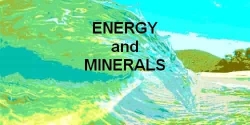SMR – Small Modular Nuclear Reactors in Australia
SMR – Small Modular Nuclear Reactors in Australia
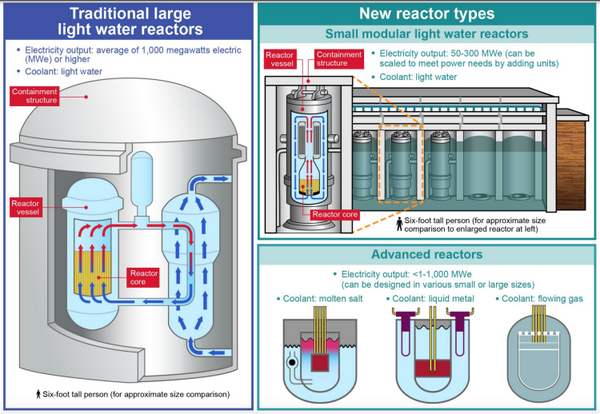
What are Small Modular Reactors?
Two Categories of SMR's
Two critical components of SMR’s
Basic Types of SMR's an overview
Nuclear Hydrogen Production
Heavy Industry Use
As Base-load Power
Prerequisites for SMRs in Australia
Sources
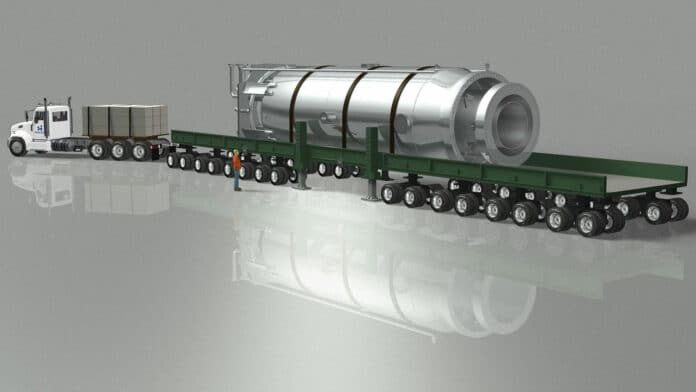
What are Small Modular Reactors?
A small modular reactor (SMR) is a factory-built nuclear reactor small enough to be transported to site.
Like all nuclear reactors SMR's produce and control the release of energy from splitting the very large unstable atoms of certain elements into smaller more stable atoms.
The smaller atoms require less energy to exist and the excess energy is released in the form of heat.
The released heat is used, most often, to generate electricity but may also be used for industrial processes.
Small Modular Reactors Come in Several Designs

The use of Small Modular Nuclear Reactors (SMR's) is being actively suggested as a means to provide base-load electrical power at sites of former coal-burning power generation stations here in Australia.
Currently, there are no licensed designs, or constructed or operating SMRs in Australia,or in any Organisation for Economic Co-operation and Development (OECD) countries.
There are 14 individual OECD designs that meet the definition of an SMR and are considered by the World Nuclear Association to be in “near term deployment – development well advanced”.
SMR's should have most, if not all, of the following features:
- standardised power plant infrastructure with a small physical footprints, small size so they can be transported to site
- factory built identical self contained modular units, rather than custom-designed
- some designs are capable of a “daisy chain” configuration - running multiple cores in one power plant
- small electrical output up to 35-350 Megawatts
- from 1 Megawatt 2/3rd is used for non-residental purposes and 1/3rd for residential use
- based on above 1 Megawatt from a SMR translates to very roughly about 20,000 homes
- safety zone reduced from about 15km to 2km, so can be built nearer urban centres
- more efficient fuel usage and less highly radioactive waste
- simplified design, fewer components, less piping
- inherent reactor passive cooling,in the case of power failure, so many designs lack a containment structure
- some designs cannot be refueled, so no refueling safety risk but you end up with a throw away reactor after maybe 30 years
Large Water Cooled Reactor Type - Currently in use overseas for Base-load electricity
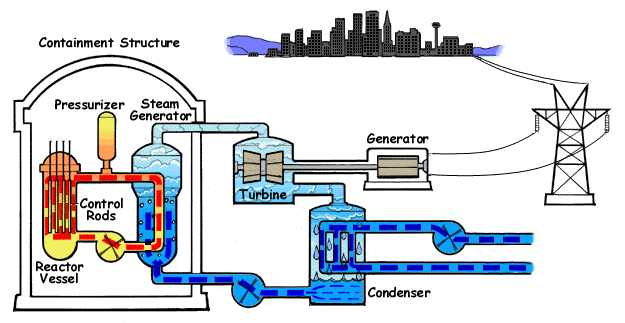
Two Categories of SMR's
Basically there are two categories of SMR reactors:
- Slow reactors that use a “moderator” to make the nuclear reactions more efficient, need a specific fuel and run at lower temperatures. They produce some very radioactive long-lived waste.
- Fast reactors that do not use a “moderator”, are less efficient but
can run on a greater range of fuels and run at very high temperatures.
The high temperatures can convert some waste into fuel. They produce
less very radioactive long-lived waste.
Uranium Oxide Fuel Pellet
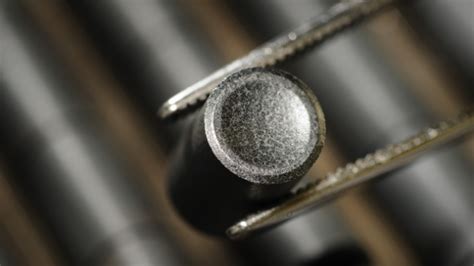
Two critical components of SMR’s
SMR's rely on two critical components: fuel and coolant.
There are numerous, diverse SMR designs employing new fuel types/configurations and innovative coolants.
- Innovative Fuels
- most commonly and in most SMR's regular, small "barrel-shaped" pellets of fuel are placed into pipes (called "rods") that can be raised, lowered,re-ordered, removed or replaced as required
- but some SMR's designs require more complex fuel -"layered spheres", "pebbles" or "prismatic blocks"
- some of these fuels are actually "mixed" in the coolant in a sort of fuel/coolant slurry
- TRISO, or tri-structural isotropic particle fuel is one of the most popular options. TRISO particles contain uranium, enclosed in ceramic and carbon-based layers. This keeps the fuel contained, keeping all the products of fission reactions inside and allowing the fuel to resist corrosion and melting.
- Other reactors use HALEU: high-assay low-enriched uranium. Most nuclear fuel used in commercial reactors contains between 3% and 5% uranium-235. HALEU, on the other hand, contains between 5% and 20% uranium-235, allowing reactors to get more power in a smaller volume.
- Innovative Coolants
- Water
- Water-cooled SMR's are the most developed designs and the most likely to be promoted if a short development time is required
- SMR's that employ water as a coolant generally suffer from the same safety issues as large nuclear reactors
- in double loop designs, one coolant loop is inside the reactor and goes to a heat exchanger where a second physically separated loop is heated to steam and sent to the electricty generator
- in single loop designs; a single loop goes both inside and outside the; reactor -there is no physical separation; leak potential of radioactive contamination exiting the reactor enclosure
- efficiency can be increased by raising temperatures and pressures through at a considerable increase in materials cost
- Gas
- large qualtities of helium or carbon dioxide need to be cooled quickly
- uses a direct Brayton cycle gas turbine in a gas stream operating at up to 750°C. for high thermal efficiency
- high temperature requires heat resistant fuels: composite ceramic fuel, advanced fuel particles, or ceramic-clad actinide compounds.
- core reactor configurations involve pin or plate-based fuel assemblies or prismatic blocks.
- Molten Salt
- liquid fuel - salt and fuel are mixed and circulate like a slurry
- uranium tetrafluoride (UF4) or thorium tetrafluoride (ThF4),dissolved in molten fluoride salt
- self regulating -temperature and reactivity correlate negatively so when the temperature goes up in the reactor, the number of nuclear fissions goes down.
- works at low pressure
- salt will solidify if not kept very hot all the time
- high grade heat can be used to make hydrogen or for industrial processes
- special alloys need to overcome corrosion risk
- refueling obscured by the opaque coolant
- coolant can flow over solid fuel like other reactors or fissile materials can be dissolved directly into the primary coolant so that the fission directly heats the salt
- Molten Metal
- molten sodium or molten lead or molten lead/bismuth
- will solidify if cooled
- high operating temperatures facilitate use of greater range of fuels
- high temperatures may be used for industrial processes rather than just electricity generation
- heat resistant fuel designs required
Heat Resistant TRISO Fuel Sphere
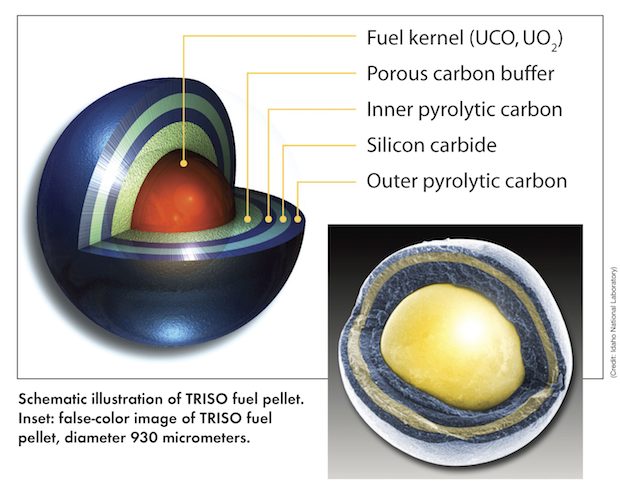
- SMR #1 - Boiling Water Reactor (BWR) 300Megawatts
- has a reactor core that heats water, which then boils and turns into steam directly within the reactor vessel.
- this steam is used to drive a turbine generator to produce electricity.
- direct production of steam within the reactor vessel.
- a single-loop system where the reactor coolant also serves as the steam source.
- use of enriched uranium as uranium oxide pellets as fuel.
- any fuel leak can make the water radioactive and that radioactivity can reach the turbine and the rest of the coolant loop
- efficiency up 35%
Basic Types of SMR's an overview
Uranium-235 (U235) is the primary fission element (nuclear fuel) across all 14 possible reactor designs.
Australia has abundant uranium reserves, including the world’s largest deposit at Olympic Dam.
The coolant is used to transfer heat and keep the reactor temperture within safe levels.
The advanced development SMRs are categorised by coolant type as below...

- SMR #2 - High Temperature Gas-cooled Reactor (HTGR) 80 Megawatts
- uses a gas, typically helium, as the coolant.
- these reactors operate at high temperatures, which makes them efficient for electricity generation and suitable for industrial process heat applications.
- use of graphite as a moderator (to slow down neutrons, allowing the fission chain reaction to continue).
- helium is used as a coolant because it does not absorb neutrons and remains chemically inert.
- huge volume of gas must be cooled before looping through system again
- some designs cannot be re-fueled
- very high operating temperatures, which can exceed 850°C.
- the heated gas spins a gas turbine which requires a critical and inaccessible magnetic bearing in the heated gas flow
- efficiency up to 41%
Gas Cooled Reactor
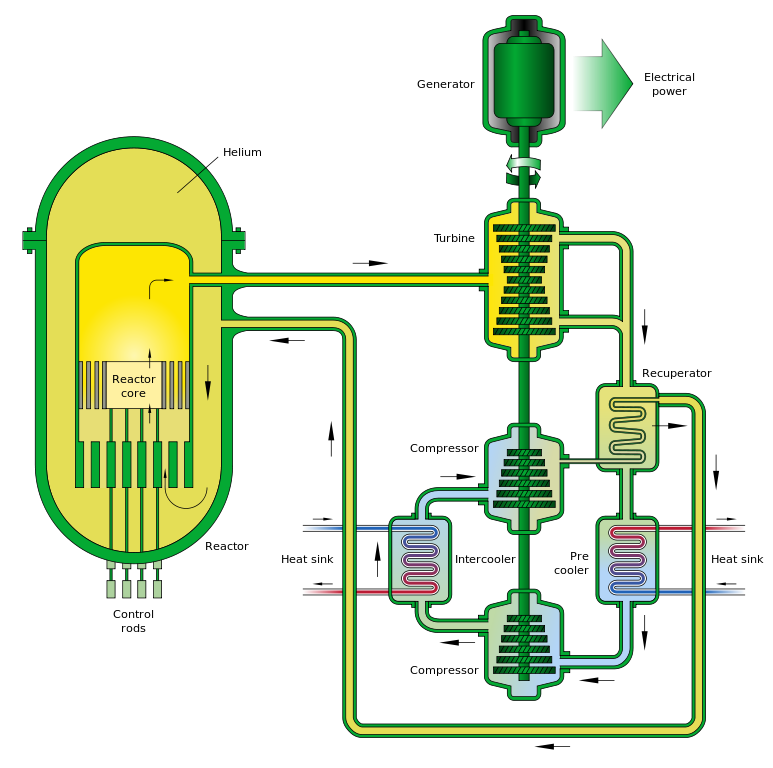
- SMRs #3, 4, 5, 6 - Molten Salt Reactor (MSR) 35-300Megawatts
- can have the reactor fuel dissolved in a molten salt (fluoride or chloride) mixture.
- these reactors also use molten salt as the primary coolant.
- MSRs can operate at high temperatures and low pressures, providing efficient thermal energy conversion.
- they are also suitable for process heat applications.
- can use molten salts as both fuel and coolant.
- refueling if feasible likely requires shutdown and draining of fuel/coolant mix
- high operating temperatures allow for efficient electricity generation.
- corrosion issues
- 850°C
Molten Salt Cooled Reactor
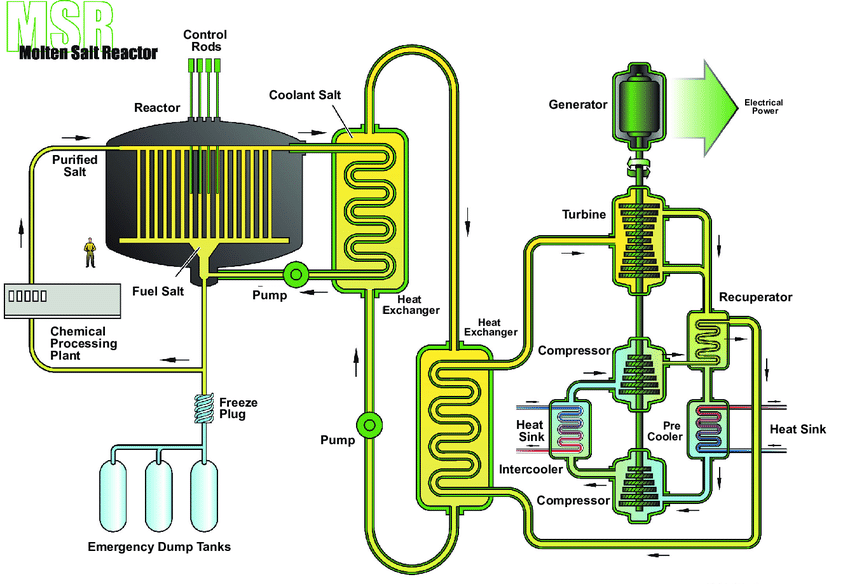
- SMRs #7, 8, 9, 10, 11. Pressurised Water Reactor (PWR) 60-300 Megawatts
- is a type of nuclear reactor that uses pressurised water as both a coolant and a neutron moderator.
- the primary loop of high-pressure water transfers heat from the reactor core to a secondary loop, where steam is generated to drive turbines.
- use of pressurised water to prevent boiling within the reactor core.
- a two-loop system separating the reactor coolant from the steam generator.
- higher pressure and temperature result in efficiency up to about 35%
- expensive piping due to heat and pressure, higher cost of components
- similar safety issues to existing Large Water Cooled Reactors
- reactor vessel visible during refueling
- uses uranium oxide pellets
- similar to Boiling Water Reactor but two water loops (one inside and one outside with a heat exchanger)
- SMRs #12, 13, 14 - Sodium or Lead or Lead-Bismuth-cooled Fast Nuclear Reactor (Liquid Metal FNR) 100-345 Megawatts
- uses liquid sodium as the coolant.
- Sodium FNRs operate at high temperatures and use fast neutrons to sustain the nuclear reaction, which allows for more efficient fuel utilisation and the ability to burn some long-lived actinides.
- these reactors can be used for process heat applications.
- liquid sodium as the coolant, which has excellent heat transfer properties.
- fast neutron spectrum, they do not use a moderator.
- high operating temperatures allow for efficient electricity generation. 550-800°C
- opaque coolant so no visibility on re-fueling
- less long lived radioactive waste
- sodium cooled uses metallic UZr with minor actinides; and the lead-cooled SMR uses mononitride-mixed fuel (UN-PuN)
- can use "spent fuel" from conventional nuclear reactor waste
- sodium reacts violently if it comes in contact with water
- operates at low pressures
- circulated by natural convection
- cement/lime 1370°C
- copper 1083°C
- lead 327°C
- zinc 419°C
- iron 1200-1530°C
- gold 1063°C
- stainless steel 1363°C
- aluminium 659°C
- ammonia via Haber-Bosch process 400-450°C
- What are the advantages / disadvantages of creating base-load electricity from multiple locations?
- In the critical time gap between now and mature renewables around ***2040 is there even enough time to proto-type, test, manufacture and install SMRs?
- Would the move to SMRs make us dependent of foreign imports of alloys, reactors and complex fuels? or Is there time to create a domestic capability from scratch?
- for the fast reactor designs would we be importing high level radioactive waste to maximise reactor efficiencies?
- have transitioned from full-scale prototypes to ongoing commercial SMRs
- delivered using well-established domestic manufacturing facilities and robust supply chains.
- have on offer a choice of SMR systems from various established and successful vendors.
- developed the expertise to refine exotic alloys, test components;
- construct, maintain and safely dispose of nuclear waste and components at end of life
- ability to make and recycle domestic nuclear fuels
- provide transparent and proven capital and operating costs from multiple operating vendors and sites.
- demonstrate the operational safety and environmental performance of SMRs in line with Australian society’s expectations.
- require a suitably scaled nuclear-power qualified local skills base.
Pressurised Water Reactor

Liquid Metal Cooled Reactor

Nuclear Hydrogen Production
High-temperature electrolysis of hydrogen is contentious, “*red hydrogen”, made through the use of nuclear energy, is not “green” as radioactive waste is a bi-product.
Thermochemical water splitting uses high temperatures—from the heat of nuclear power reactions—and chemical reactions to produce hydrogen and oxygen from water.
Thermochemical water splitting processes use high-temperature heat (500°–2,000°C) to drive a series of chemical reactions that produce hydrogen.
The chemicals used in the process are reused within each cycle, creating a closed loop that consumes only water and produces hydrogen and oxygen
Four chemical cycles cycles,appear to have some merit; namely Cu-Cl, V-Cl, Mg-Cl and S-I cycles, with efficiencies of 52.6%, 69%, 63.63% and 46.9%.
In comparison using electrolysis of water from renewable sources can have efficiencies as high as 70%
So comparable to that of the; simple electrolysis of water. All processes entail a very large input of energy.
At 100% efficiency it would take 9 litres of pure water and 50-55Kw of electricty to produce 1 litre of hydrogen fuel.
The average Australian household consumes 18Kw of electricity per day.
Only practical if "waste" heat is used for hydrogen production ie. an additional benefit of an otherwise unused resource
Given the high temperatures required for thermochemical "red" hydrogen production is would seem that only gas-cooled and molten salt cooled reactors could supply sufficiently temperature.
Both gas-cooled and molten salt-cooled systems still require a long prototype and testing timelines.
Heavy Industry Use
Gas cooled molten salt cooled and molten metal cooled reactors seem to be the only SMR designs capable of waste heat output in the range of 800-850°C
This may be useful in intense non-electrical industries, such as chemical manufacturing, cement/lime production, primary metals manufacturing, synthetic fuels and ammonia.
What temperatures would be needed ?
Practically speaking using waste heat from SMRs for industrial processes would be a win/win situation.
It is difficult to determine which chemical processes would suit the use of waste heat but this would seem to be the most likely application.
For lead, zinc, and ammonia waste heat seems to be a possibility.
Aluminium production requires electricity so that is not practical.
For all other listed processes the heat requirement substantially exceeds the maximum waste heat temperature.
To achieve temperatures above waste heat maximums would necessitate the addition of electrical energy most likely electric arc furnaces - not a win/win.
Not mentioned in sources? Maybe using excess heat of SMRs for desalination of sea water as insurance for our climate-affected major food growing areas.
As Base-load Power
SMR's are able to produce electricity continuously so are best suited for base-load power.
Questions arise:
*** assumes that by 2040 battery storage, pumped hydro or other storage means are in place
Prerequisites for SMRs in Australia"
In order for Australia to build and maintain its own SMRs and not be reliant on foreign powers :
Changes in National and State Legislation would be necessary...
Commonwealth law, under Section 140A of the Environment Protection and Biodiversity Conservation Act 1999 (EPBC Act), creates a moratorium in the construction and operation of nuclear power plants.
There is also moratorium legislation in Queensland, NSW and Victoria
Fastest option would be Boiling water or Pressurisd water designs as these are the most advanced.
However both suffer from many of the same concerns the public has over Large Scale Light Water facilities.
Gas, Molten Salt and Molten Metal designs with their high heat output an fuel efficiencies are best for industrial applications / fuel efficiencies but are currently the least developed designs.
It will likely take many years to design components, manufacture components, test components, build proto-types, test to proto-types to destruction, develop working models, test working models over periods of time, develop factory style commercial fabrication facilities, deploy SMRs. Say it takes two years at each of these stages then we are looking at a very minimum of 20years to deployment - well past 2040.
The development / manufacture / recycling of complex fuel types creates another unpredictable timeline on its own.
If we are looking for a base-load coal replacement solution to be in place by 2030-2040 SMRs are not going to be a realistic choice.
SMRs into a mature renewables environment after 2040 would be impractically expensive.
Sources
https://publications.jrc.ec.europa.eu/repository/bitstream/JRC125565/kjna30764enn.pdf
https://en.wikipedia.org/wiki/Small_modular_reactor
https://www.ansto.gov.au/news/small-modular-reactors-an-overview
https://aris.iaea.org/
https://www.ansto.gov.au/news/small-modular-reactors-can-be-built-generation-iv-reactor-designs
https://en.wikipedia.org/wiki/Generation_IV_reactor
https://www.energy.gov/ne/articles/3-advanced-reactor-systems-watch-2030
http://large.stanford.edu/courses/2021/ph241/lecroy1/
(Woodhead Publishing in energy) Mario D. Carelli (editor)_ D. T. Ingersoll (editor) - Handbook of small modular nuclear reactors-Elsevier Inc., Woodhead Publishing (2021)
https://www.nrc.gov/docs/ML1214/ML12142A089.pdf
https://www.vox.com/23771809/nuclear-power-smr-small-modular-reactor-energy-climate-nuscale
https://45nuclearplants.com/wp-content/uploads/2015/05/nuclear_reactor_design_types.jpg
https://tdb.oecd-nea.org/jcms/pl_69716/management-of-spent-fuel-radioactive-waste-and-decommissioning-in-smrs-or-advanced-reactor-technologies
https://www.gen-4.org/gif/jcms/c_59461/generation-iv-systems
https://www.inceptivemind.com/nuscale-power-shell-produce-clean-hydrogen-using-small-modular-reactor/
https://www.atse.org.au/what-we-do/strategic-advice/small-modular-reactors-the-technology-and-australian-context-explained/
https://www.atse.org.au/media/u3dpod5y/atse-small-modular-reactors-240822.pdf
https://www.researchgate.net/profile/Mahesh_Jayakody2/publication/358989391/figure/fig8/AS:1129690974691330@1646350725728/Schematic-diagram-of-a-boiling-water-reactor-source-wwwtheietorg-factfiles.png
https://learnmech.com/wp-content/uploads/2018/07/Pressurized-Water-Reactor-PWR-Advantages-and-Disadvantages.jpg
https://www.abc.net.au/news/2024-06-11/nuclear-power-for-australia-cost-and-timelines-explained/103641602

